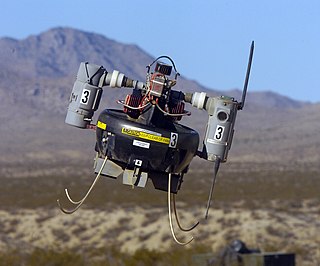
The Defense Advanced Research Projects Agency (DARPA) is a research and development agency of the United States Department of Defense responsible for the development of emerging technologies for use by the military.

MEMS is the technology of microscopic devices incorporating both electronic and moving parts. MEMS are made up of components between 1 and 100 micrometres in size, and MEMS devices generally range in size from 20 micrometres to a millimetre, although components arranged in arrays can be more than 1000 mm2. They usually consist of a central unit that processes data and several components that interact with the surroundings.
Microtechnology deals with technology whose features have dimensions of the order of one micrometre. It focuses on physical and chemical processes as well as the production or manipulation of structures with one-micrometre magnitude.

A micro air vehicle (MAV), or micro aerial vehicle, is a class of miniature UAVs that has a size restriction and may be autonomous. Modern craft can be as small as 5 centimeters. Development is driven by commercial, research, government, and military purposes; with insect-sized aircraft reportedly expected in the future. The small craft allows remote observation of hazardous environments inaccessible to ground vehicles. MAVs have been built for hobby purposes such as aerial robotics contests and aerial photography.
Brain implants, often referred to as neural implants, are technological devices that connect directly to a biological subject's brain – usually placed on the surface of the brain, or attached to the brain's cortex. A common purpose of modern brain implants and the focus of much current research is establishing a biomedical prosthesis circumventing areas in the brain that have become dysfunctional after a stroke or other head injuries. This includes sensory substitution, e.g., in vision. Other brain implants are used in animal experiments simply to record brain activity for scientific reasons. Some brain implants involve creating interfaces between neural systems and computer chips. This work is part of a wider research field called brain–computer interfaces.

Remote control animals are animals that are controlled remotely by humans. Some applications require electrodes to be implanted in the animal's nervous system connected to a receiver which is usually carried on the animal's back. The animals are controlled by the use of radio signals. The electrodes do not move the animal directly, as if controlling a robot; rather, they signal a direction or action desired by the human operator and then stimulate the animal's reward centres if the animal complies. These are sometimes called bio-robots or robo-animals. They can be considered to be cyborgs as they combine electronic devices with an organic life form and hence are sometimes also called cyborg-animals or cyborg-insects.

Microfabrication is the process of fabricating miniature structures of micrometre scales and smaller. Historically, the earliest microfabrication processes were used for integrated circuit fabrication, also known as "semiconductor manufacturing" or "semiconductor device fabrication". In the last two decades microelectromechanical systems (MEMS), microsystems, micromachines and their subfields, microfluidics/lab-on-a-chip, optical MEMS, RF MEMS, PowerMEMS, BioMEMS and their extension into nanoscale have re-used, adapted or extended microfabrication methods. Flat-panel displays and solar cells are also using similar techniques.

Micropumps are devices that can control and manipulate small fluid volumes. Although any kind of small pump is often referred to as micropump, a more accurate definition restricts this term to pumps with functional dimensions in the micrometer range. Such pumps are of special interest in microfluidic research, and have become available for industrial product integration in recent years. Their miniaturized overall size, potential cost and improved dosing accuracy compared to existing miniature pumps fuel the growing interest for this innovative kind of pump.
Smart systems incorporate functions of sensing, actuation, and control in order to describe and analyze a situation, and make decisions based on the available data in a predictive or adaptive manner, thereby performing smart actions. In most cases the “smartness” of the system can be attributed to autonomous operation based on closed loop control, energy efficiency, and networking capabilities.

A cyborg —a portmanteau of cybernetic and organism—is a being with both organic and biomechatronic body parts. The term was coined in 1960 by Manfred Clynes and Nathan S. Kline.
A MEMS magnetic actuator is a device that uses the microelectromechanical systems (MEMS) to convert an electric current into a mechanical output by employing the well-known Lorentz Force Equation or the theory of Magnetism.
Mark G. Allen is a professor specializing in microfabrication, nanotechnology, and microelectromechanical systems at the University of Pennsylvania, where he is currently Alfred Fitler Moore Professor of Electrical and Systems Engineering Director of the Singh Center for Nanotechnology, and leader of the Microsensor and Microactuator Research Group. Prior to his joining the University of Pennsylvania in 2013, he was with the Georgia Institute of Technology, where he was Regents' Professor of Electrical and Computer Engineering and the J.M. Pettit Professor in Microelectronics. While at Georgia Tech, he also held multiple administrative positions, including Senior Vice Provost for Research and Innovation; Acting Director of the Georgia Electronic Design Center; and Inaugural Executive Director of Georgia Tech's Institute for Electronics and Nanotechnology. He was editor in chief of the Journal of Micromechanics and Microengineering (JMM), and currently serves on the editorial board of JMM as well as the journal Microsystems and Nanoengineering.
Microelectromechanical system oscillators are devices that generate highly stable reference frequencies to measure time. The core technologies used in MEMS oscillators have been in development since the mid-1960s, but have only been sufficiently advanced for commercial applications since 2006. MEMS oscillators incorporate MEMS resonators, which are microelectromechanical structures that define stable frequencies. MEMS clock generators are MEMS timing devices with multiple outputs for systems that need more than a single reference frequency. MEMS oscillators are a valid alternative to older, more established quartz crystal oscillators, offering better resilience against vibration and mechanical shock, and reliability with respect to temperature variation.
The Microsystems Technology Office (MTO) is one of seven current organizational divisions of DARPA, an agency responsible for the development of new technology for the United States Armed Forces. It is sometimes referred to as the Microelectronics Technology Office.

Roger Thomas Howe is the William E. Ayer Professor of Electrical Engineering at Stanford University. He earned a B.S. degree in physics from Harvey Mudd College and M.S. and Ph.D. degrees in electrical engineering from the University of California, Berkeley in 1981 and 1984, respectively. He was a faculty member at Carnegie-Mellon University in 1984-1985, at the Massachusetts Institute of Technology from 1985-1987, and at UC Berkeley between 1987-2005, where he was the Robert S. Pepper Distinguished Professor. He has been a member of the faculty of the School of Engineering at Stanford since 2005.

Andrei M. Shkel is a Professor of Mechanical and Aerospace Engineering at the University of California, Irvine. He was named Fellow of the Institute of Electrical and Electronics Engineers (IEEE) in 2014 "for contributions to micromachined gyroscopes". He served as the President of the IEEE Sensors Council (2020-2021). In 2021, he was elected to National Academy of Inventors (NAI) Fellow status. He is currently the Editor-in-Chief of the IEEE Sensors Letters.
John X. J. Zhang is a tenured professor at Thayer School of Engineering of Dartmouth College, and an investigator in the Dartmouth-Hitchcock Medical Center. Before joining Dartmouth, he was an associate professor with tenure in the Department of Biomedical Engineering at the University of Texas(UT Austin). He received his Ph.D. in electrical engineering from Stanford University, California in 2004, and was a research scientist in systems biology at the Massachusetts Institute of Technology (MIT) before joining the faculty at UT Austin in 2005. Zhang is a Fellow of the American Institute for Medical and Biological Engineering (AIMBE), and a recipient of the 2016 NIH Director's Transformative Research Award.

Niels Quack is a Swiss and German engineer specialized in optical micro engineering. He is a SNSF professor at EPFL and director of the Photonic Micro- and Nanosystems Laboratory at its school of engineering.

Ha Duong Ngo is an academician, research scholar in the field of Electrical Engineering/Microsystems Engineering.
Pritiraj Mohanty is a physicist and entrepreneur. He is a professor of physics at Boston University. He is most known for his work on quantum coherence, mesoscopic physics, nanomechanical systems, and nanotechnology with a recent focus on biosensing and nanomechanical computing.









